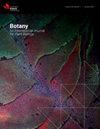茶树的分泌系统:表皮细胞的双区室化、腺附属物的重新分类和水合器官的首次报道
IF 1.3
4区 生物学
Q3 PLANT SCIENCES
引用次数: 0
摘要
茶茶。& Schltdl。是一种在不同环境条件下生长的蓟科亚灌木。这种植物的空中部分具有药用价值,可用于生产肥皂。为了进一步了解花椒叶和茎的分泌系统,我们对花椒叶和茎的分泌细胞和组织进行了结构、超微结构和组织化学分析。具有表皮、管状分子和气孔的水合孔出现在叶片边缘,这是首次在Cuphea物种中被描述。腺体附属物出现在叶和茎中,其特点是基部宽,顶部较窄,渗出粘性物质。个体发生分析表明,这些附属物是腺状突起;它们的细胞中产生了酚类化合物、粘液和脂质,这些细胞表现出高尔基体、囊泡、光滑的内质网、油滴和质体。叶片的表皮具有双区室的分泌细胞,在其赤道区域由纤维素隔膜分隔。这些细胞在上隔室含有酚类化合物,在下隔室含有粘液。我们的研究结果揭示了calophylla中产生生物活性化合物的位点,扩大了对Lythraceae中分泌系统的认识,促进了对calophylla的重新分类和新结构的鉴定。本文章由计算机程序翻译,如有差异,请以英文原文为准。
Secretory system in Cuphea calophylla (Lythraceae): the bi-compartmentalization of epidermal cells, reclassification of glandular appendages, and the first report of hydathodes
Cuphea calophylla Cham. & Schltdl. is a Lythraceae subshrub that occurs in different environmental conditions. The aerial portions of this plant have medicinal properties and are used for soap production. We assessed the structure, ultrastructure, and histochemistry of the secretory cells and tissues in C. calophylla leaves and stems to further understand its secretory system. Hydathodes with epithem, tracheary elements, and water pores occur at the leaf border and are here described for the first time for a Cuphea species. Glandular appendages occur in leaves and stems and are characterized by a wide basis and a narrower apical portion that exuded sticky material. Ontogenetical analysis showed that these appendages are glandular emergences; phenolic compounds, mucilage, and lipids were produced in their cells which exhibited Golgi bodies, vesicles, smooth endoplasmic reticulum, oil drops, and plastids. The epidermis of the leaf blade has bi-compartmentalized secretory cells divided by a cellulosic septum in their equatorial region. These cells contain phenolic compounds in the upper compartment and mucilage in the lower compartment. Our results shed light on the sites producing bioactive compounds in C. calophylla and expand the knowledge on the secretory system in Lythraceae, promoting a reclassification and an identification of new structures.
求助全文
通过发布文献求助,成功后即可免费获取论文全文。
去求助
来源期刊

Botany
生物-植物科学
CiteScore
2.20
自引率
9.10%
发文量
48
期刊介绍:
Botany features comprehensive research articles and notes in all segments of plant sciences, including cell and molecular biology, ecology, mycology and plant-microbe interactions, phycology, physiology and biochemistry, structure and development, genetics, systematics, and phytogeography. It also publishes methods, commentary, and review articles on topics of current interest, contributed by internationally recognized scientists.
 求助内容:
求助内容: 应助结果提醒方式:
应助结果提醒方式:


